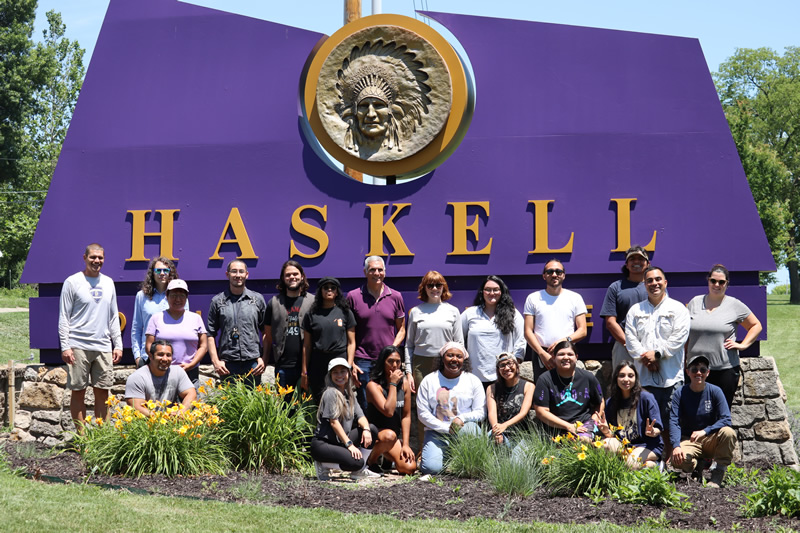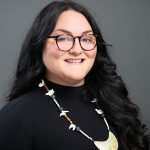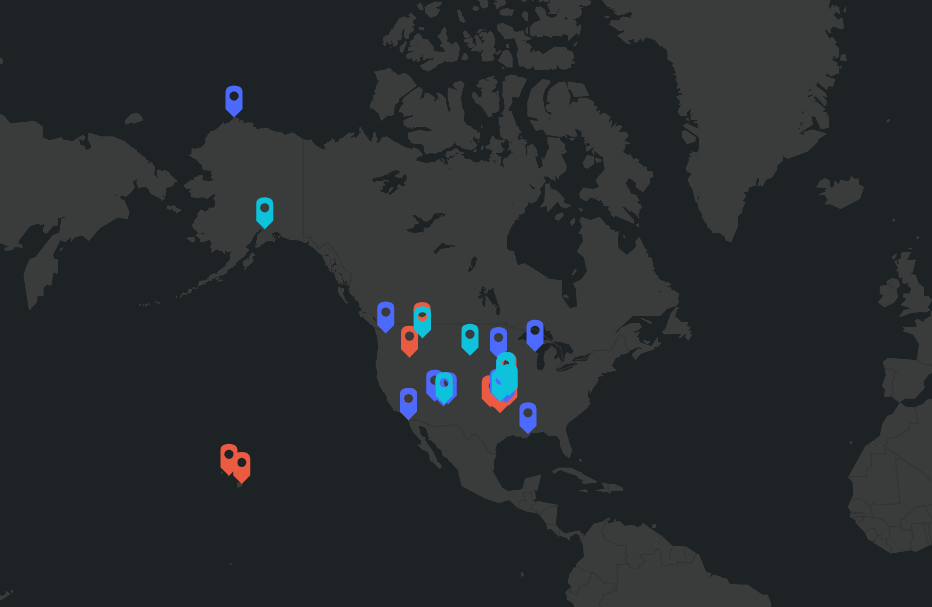
Growing up as a citizen of the Cherokee Nation, Annalise Guthrie never expected to have a career in science. She is not alone. Only about 16% of Native Americans attain bachelor’s degrees with far fewer going to graduate school in the sciences.
But wise role models and supportive learning experiences changed her life.
This is the goal of the Haskell Environmental Research Studies (HERS) Institute. The eight-week summer program in Lawrence, Kansas, seeks to prepare indigenous undergraduate students for graduate school through mentoring and learning experiences, in and out of the classroom. The program started as the brainchild of Daniel Wildcat, Professor of Indigenous and American Indian Studies at Haskell Indian Nations University. In 2009, Dr. Wildcat teamed up with Joane Nagel, KU distinguished professor of sociology, to establish HERS as an ongoing partnership between Haskell and Kansas NSF EPSCoR.
Since its first summer in 2009, HERS has trained 110 Native students with affiliations to 60 tribal communities across the country. And 45 of the interns have gone to graduate school.
That’s a remarkable feat given that Native Americans and Alaskan Natives made up less than one percent of doctorate recipients in the sciences from 2010 to 2020 according to a national report.
“We’re really trying our best to turn that around,” said Jay T. Johnson, director of the HERS Institute and professor of geography and atmospheric science at the University of Kansas. He leads the program with faculty from Haskell Indian Nations University.
Annalise is a trailblazing success story, as one of 13 interns in the 2021 HERS Institute.
From training in the HERS program and other opportunities like the University of Kansas PREP program, Annalise learned how to write research proposals and conduct a research project. She now attends KU, pursuing a PhD in ecology and evolutionary biology with guidance from Professor Sharon Billings and funding from a prestigious National Science Foundation (NSF) fellowship.
Funding for HERS comes from Kansas NSF EPSCoR, which stands for the “Established Program to Stimulate Competitive Research.” NSF uses EPSCoR to level the playing field for areas in the country whose scientists receive a lower percentage of federal support.
HERS will welcome its tenth cohort of interns in summer 2022, a milestone that also coincides with the 30th anniversary of the launch of NSF EPSCoR in Kansas.
Annalise hopes to assist with the 2022 summer HERS program, mentoring the next cohort and giving back to her community just as other HERS alumni have done since the program started. She is also on track to pursue a career that will help her tribal community. This calling became apparent to her during the HERS program when she realized that any one of the students in her cohort could be the scientists who do research to mitigate the major problems facing indigenous communities.
“It was empowering for me,” said Annalise. “I wasn’t sure before [about helping my tribe] but this is where I’m going to take it. This is where I feel at home.”

Annalise Guthrie
2021 HERS Intern, Citizen of Cherokee Nation of Oklahoma
After graduating from Haskell Indian Nations University, Annalise now seeks a doctorate in ecology and evolutionary biology at the University of Kansas.
What makes HERS so successful?
Much of the enduring success of the HERS Institute relies on building connections across cultures.
“If you want native students to identify as scientists, they need to see direct evidence that science can address an issue of importance to their community,” said Dr. Johnson.
The interns start with ideas about how their communities are suffering from climate change and other environmental issues. Then, the instructors help the students refine their ideas into research projects.
“We basically teach them everything they need to know to turn an idea into a research question and a research proposal,” said Dr. Johnson.
The writing intensive program goes from classroom instruction about climate change, GIS mapping, and other science concepts to field work and community-engagement.
“We tour the Haskell wetlands and the Konza prairie,” said Dr. Johnson, “and we recently began collaborating with the Oneida tribe in Green Bay, Wisconsin.” This unique addition to the program gives students a chance to work with a tribal community to address authentic and pressing challenges.
The interns are mentored by graduate students at KU, many of whom are HERS alumni. Their support for the interns extends beyond the summer, creating a network to last into their professional careers.
Dr. Johnson said that the instructors also use the practice of “two-eyed-seeing” to ensure that the interns learn to view the world through both a Western scientific lens (or eye) while also firmly holding onto the Native perspective.
Clearly, this type of instruction makes a difference, as shown by the research posters that the interns create at the end of the summer.
The HERS Institute is now accepting applications from undergraduates across the country for summer 2022. Contact Katrina McClure if you have questions.

This map shows the hometowns of HERS interns from 2018 (light blue), 2019 (dark blue), and 2021 (red). Since 2009, HERS has trained 110 Native students and 45 of the interns have gone to graduate school.
How did HERS get its start?
The story of the Haskell Environmental Research Studies Institute stretches back to more than a decade ago, when Haskell Professor Daniel Wildcat founded the program, then called HERS Center, with colleagues from Kansas State University. As a Yuchi member of the Muscogee Nation of Oklahoma, Dr. Wildcat is a climate activist and founding director of the Haskell Environmental Research Studies Center, now known as the HERS Institute.
The successful HERS summer program has continued to be a key part of the subsequent EPSCoR projects in Kansas, including the current microbiome initiative. With the 10th HERS cohort of summer interns, set for 2022, the program expects to train 15 more interns to bring the total number up to 125 Native students.
Each new cohort builds on the success of the last, with several noteworthy achievements to date.
For example, a paper by 2019 HERS alumnus, Tyler Gerkin, won the Indigenous Peoples’ Specialty Group of the Association of American Geographers Graduate Student Writing Award for 2020.
Another HERS alumnus, Ma’Ko’Quah Abigail Jones, ran for election to the Lawrence City Commission. She is also a member of the Lawrence Sustainability Advisory Board, and founder and chair of the Native American Caucus of the Kansas Democratic Party.
A former HERS curriculum coordinator and doctoral student at KU, Dr. Victoria Walsey, received the 2020 Blanchard Faculty Member of the Year Award from the American Indian College Fund for her work at Northwest Indian College.
What do the interns say about HERS?
“[It was an] incredible journey of connecting with my Native peers and scholars who taught me to stay true to who you are in western society and continue practicing the good medicine of laughter.” —2021 intern Autumn Powell
“The HERS program has exceeded my wildest expectations; I’ve interacted with passionate Tribal Native individuals, scholars, and learned about the uniqueness of everyone’s cultures. Learning about the challenges faced by other Indigenous communities has inspired me to continue my education and work toward change.” —2021 intern Caitlin “Kili” Kawaiae
“The HERS internship has been a massive benefit by exponentially raising our communication skills, research ability, and being a phenomenal starter experience into the higher levels of academics.” —2021 intern Quinton Hurlburt
“The HERS experience has been unforgettable, and it has inspired me to support and fight for the rights of Indigenous peoples.” —2021 intern Mikayla Kerron
